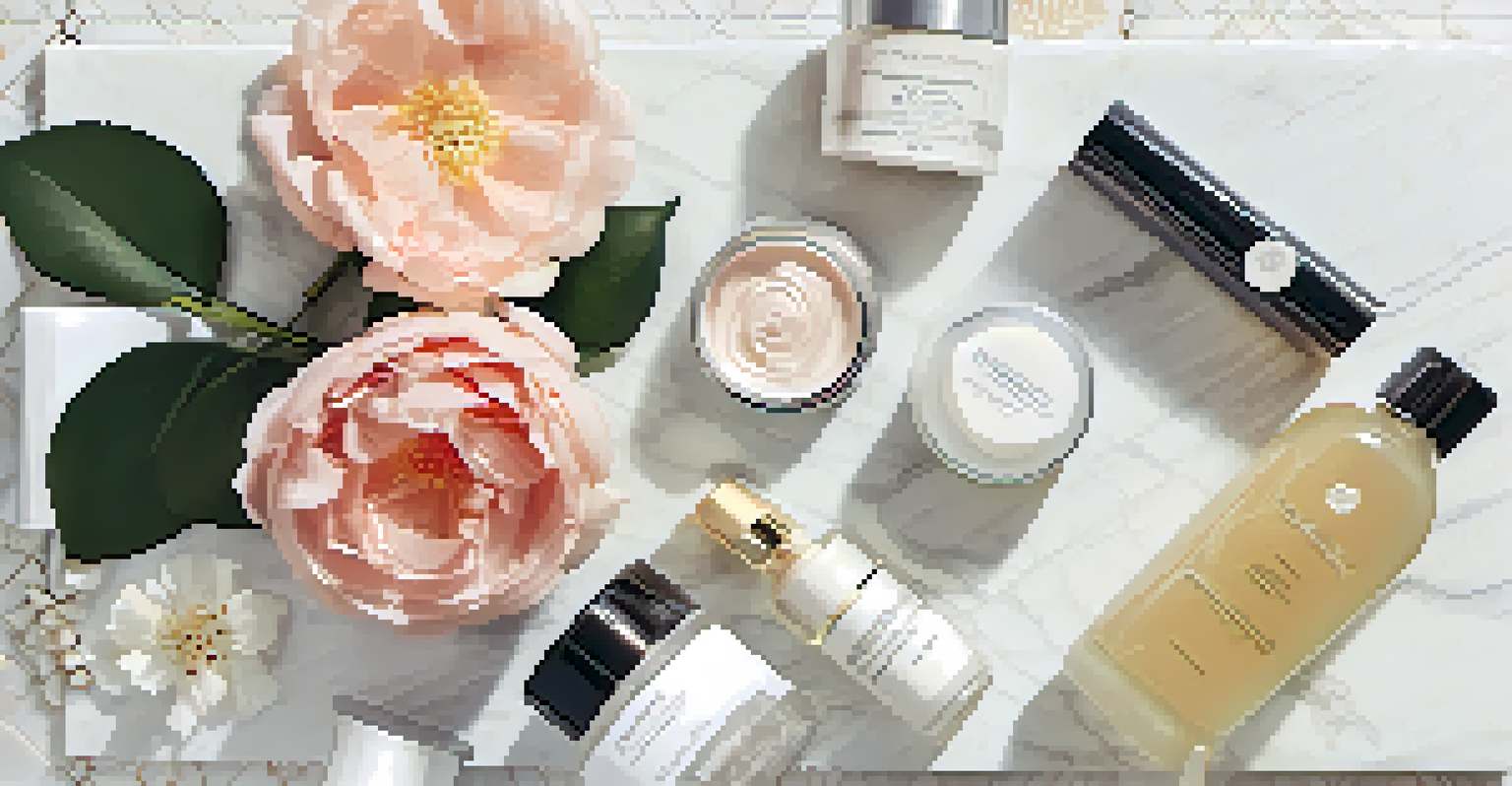Measuring ROI of Luxury Influencer Marketing Campaigns

Understanding ROI in Luxury Influencer Marketing
Return on Investment (ROI) is a critical metric that helps brands evaluate the effectiveness of their marketing strategies. In luxury influencer marketing, it measures the profitability gained from influencer collaborations against the costs involved. This understanding is paramount, as luxury brands often invest significantly in partnerships with high-profile influencers.
Marketing is no longer about the stuff you make, but about the stories you tell.
Luxury influencer marketing isn't just about immediate sales; it's about brand positioning and long-term value as well. Brands need to focus on both quantitative and qualitative metrics to truly grasp their ROI. For instance, while sales figures provide clear data, factors like brand sentiment and awareness also play a pivotal role in measuring overall success.
To accurately assess ROI, brands should establish specific goals before launching a campaign. This could range from increasing website traffic to enhancing brand recognition. By defining these objectives upfront, brands can better tailor their measurement strategies and gauge the campaign's impact.
Setting Clear Objectives for Campaigns
Before diving into influencer partnerships, it's essential to outline clear and measurable objectives. Whether the aim is to boost sales, increase social media followers, or enhance brand visibility, having defined goals will guide the campaign. Think of it as a roadmap that helps ensure all efforts align with the desired outcomes.

For example, if a luxury brand wants to increase engagement on their Instagram page, they might set a specific target, like achieving a 20% increase in likes and comments within a month. With these goals in mind, brands can choose influencers whose audiences match their target demographic, maximizing the chances of success.
Understanding ROI in Influencer Marketing
ROI measures the profitability of influencer collaborations compared to the costs, emphasizing both immediate sales and long-term brand value.
Moreover, setting objectives not only provides clarity for the campaign but also establishes benchmarks for measuring success. This way, brands can track their progress in real-time, allowing for adjustments if necessary, ensuring they stay on the path to achieving their desired ROI.
Choosing the Right Influencers for Your Brand
Selecting the right influencers is crucial to the success of any luxury marketing campaign. Luxury brands should look for influencers whose personal brand aligns with their values and aesthetics. This alignment fosters authenticity, making the collaboration feel more genuine and engaging for the audience.
It's not about what you sell, but about how you make your customers feel.
It's also vital to consider the influencer's engagement rates, not just their follower counts. An influencer with a smaller, but highly engaged audience can yield better results than one with millions of followers who rarely interacts with their audience. This focus on engagement helps ensure that the message resonates with potential customers.
In addition, brands should analyze past campaign performances of influencers to gauge their effectiveness. Reviewing metrics like conversion rates and audience feedback can provide valuable insights into how well an influencer might perform for a luxury brand's specific goals.
Tracking Performance Metrics Effectively
Once the campaign is underway, tracking performance metrics becomes essential to measure ROI. Brands should monitor various metrics such as website traffic, conversion rates, and social media engagement. These indicators provide a clear picture of how the influencer's audience is responding to the campaign.
Tools like Google Analytics can help brands assess the direct impact of influencer promotions on their website traffic and sales. By examining referral sources, brands can pinpoint which influencer drove the most traffic or conversions, helping to refine future strategies.
Setting Measurable Campaign Goals
Clear objectives guide luxury influencer campaigns, helping brands align their strategies and track success effectively.
Additionally, sentiment analysis can offer insights into how the audience perceives the brand after the campaign. Monitoring comments, shares, and overall engagement can highlight shifts in brand perception, providing valuable feedback beyond just sales figures.
Calculating the Financial ROI of Campaigns
To calculate the financial ROI of a luxury influencer marketing campaign, brands can use a straightforward formula: (Net Profit / Cost of Investment) x 100. This calculation gives a clear percentage that indicates how much profit was generated for every dollar spent on the campaign. Understanding this number is fundamental for assessing the campaign's financial success.
For instance, if a brand spent $10,000 on an influencer campaign and generated $50,000 in sales, the ROI would be calculated as follows: (($50,000 - $10,000) / $10,000) x 100 = 400%. A 400% ROI indicates a highly successful campaign, showcasing the effectiveness of the investment.
However, it's essential to remember that ROI is not solely about immediate financial returns. Brands should also consider the long-term benefits, such as increased brand loyalty and customer lifetime value, which can significantly enhance the overall ROI over time.
Evaluating Brand Awareness and Sentiment Changes
While financial metrics are crucial, evaluating brand awareness and sentiment is equally important in luxury influencer marketing. A successful campaign should elevate brand recognition and foster positive sentiment among the target audience. Surveys and social media listening tools can help assess how the audience perceives the brand post-campaign.
For example, brands can conduct pre-and post-campaign surveys to measure shifts in brand recognition and customer attitudes. If a significant percentage of respondents report being more familiar with the brand after the campaign, it's a good indicator of increased brand awareness.
Adapting Based on Performance Insights
Analyzing campaign results enables brands to refine strategies, ensuring future influencer marketing efforts are more effective.
Additionally, tracking social media mentions and sentiment analysis can provide insights into how the campaign influenced public perception. Positive comments and shares indicate a successful connection with the audience, adding another layer to understanding ROI beyond financial metrics.
Adapting Strategies Based on Insights Gained
After analyzing the results of a luxury influencer marketing campaign, brands should take time to reflect on the insights gained. This evaluation process is crucial for understanding what worked well and what could be improved in future campaigns. By treating each campaign as a learning opportunity, brands can refine their strategies and enhance their overall approach.
For instance, if a particular influencer drove a high engagement rate, brands might consider collaborating with them again or exploring similar influencers. Conversely, if certain strategies didn't yield the expected results, brands can pivot and experiment with new tactics to better meet their objectives.

Adapting strategies based on insights not only improves future campaigns but also helps brands stay relevant in a rapidly changing market. This willingness to learn and evolve can significantly enhance a brand's long-term success in luxury influencer marketing.
The Future of Luxury Influencer Marketing ROI Measurement
As luxury brands continue to invest in influencer marketing, measuring ROI will evolve alongside the industry. With advancements in technology, brands will have access to more sophisticated tools and analytics that can provide deeper insights into campaign performance. This evolution will make it easier for brands to track their investments and understand the full spectrum of their marketing efforts.
Emerging trends, such as the rise of video content and live streaming, will also impact how ROI is measured. Brands may need to adapt their metrics to account for new engagement formats and audience interactions, ensuring they capture the true essence of their campaigns.
Ultimately, the future of measuring ROI in luxury influencer marketing lies in a balance between quantitative and qualitative analysis. By embracing both aspects, brands can gain a comprehensive understanding of their marketing effectiveness and continue to thrive in the competitive luxury landscape.